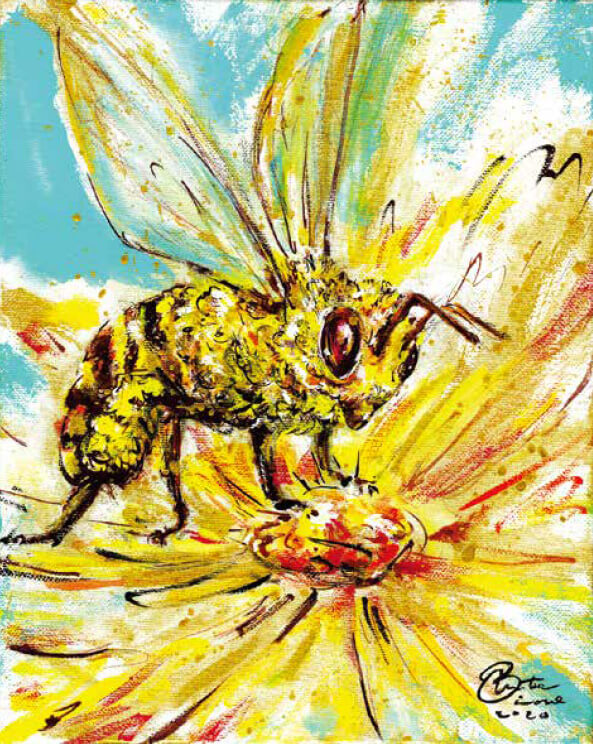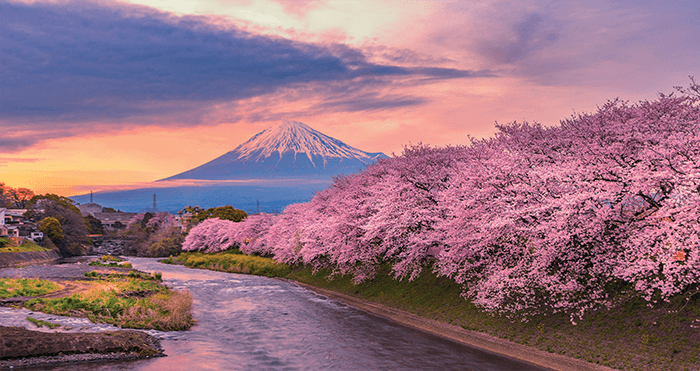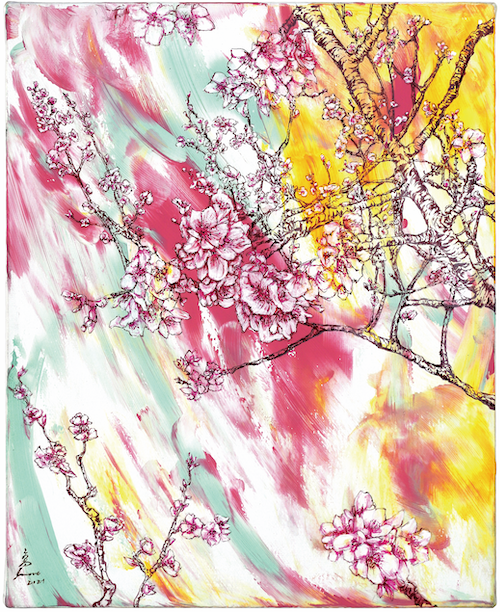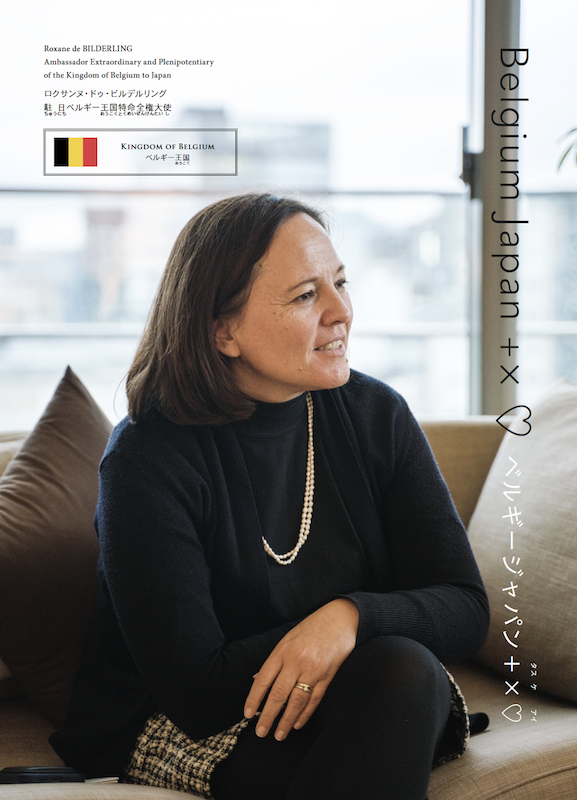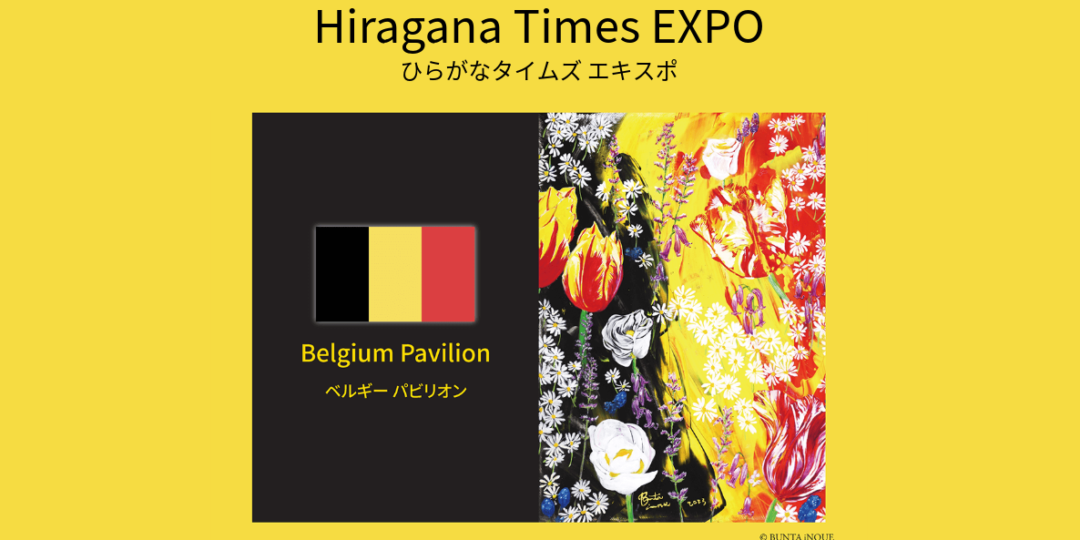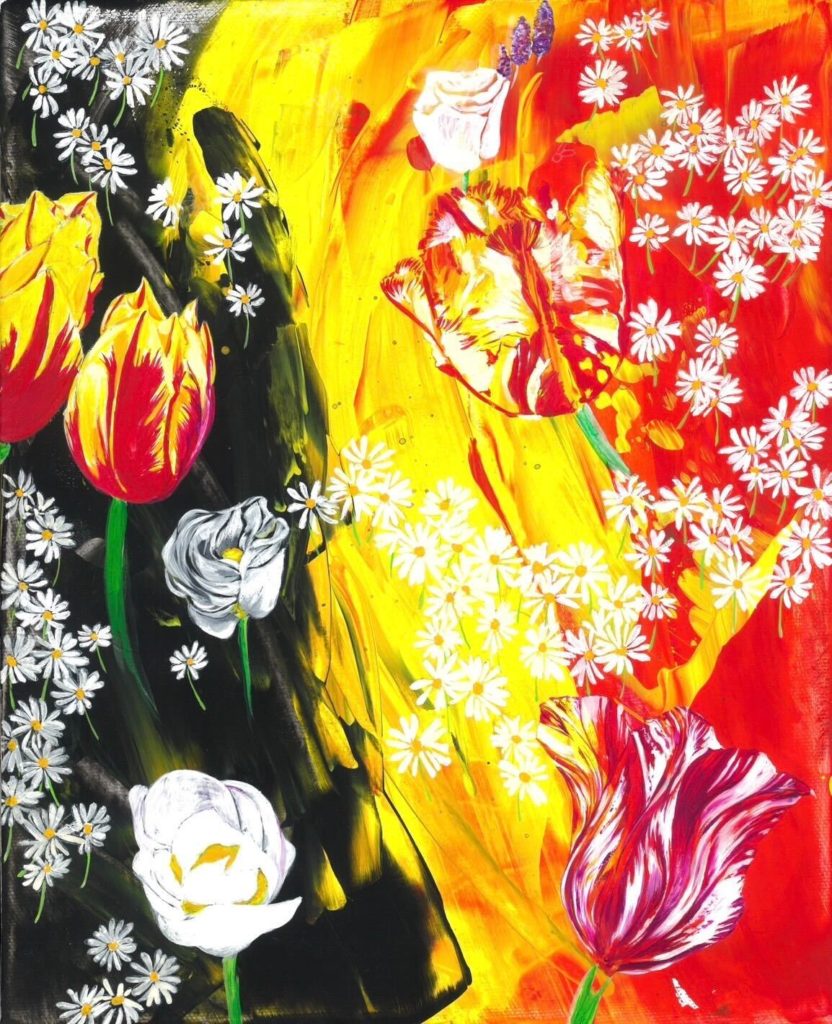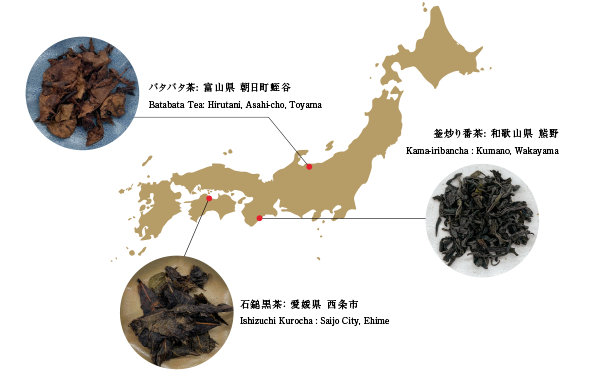-
A painting of a bull celebrating the peace and stability of heaven and earth, under the protection of the Lord of the Big Dipper.
- Hiragana Times
- Oct 18, 2024
A painting of a bull celebrating the peace and stability of heaven and earth, under the protection of the Lord of the Big Dipper.
北斗星君天地安泰喜牛図[Cover Story – November 2024 Issue]
This painting by Bunta Inoue was created in 2021, the Year of the Ox, during “Tenchosetsu” (the Emperor’s Birthday) with prayers for “Tenchou Chikyuu” (long-lasting peace and stability).
井上文太氏によるこの絵画は、2021年丑年の「天長節」(天皇誕生日)に「天長地久」の祈りを込めて描かれたものです。
“Tenchosetsu” is a holiday that prays for the Emperor’s longevity and national peace, based on the ancient Chinese concept of “Tenchou Chikyuu.”
「天長節」は天皇の長寿と国家の平和を祈る祝日で、古代中国の「天長地久」の概念に基づきます。
This phrase expresses the wish for both heaven and earth to last forever, along with human life and societal stability.
この「天長地久」は、天と地が永続するように、人の寿命や社会の安定も続くべきという願いが込められた言葉です。
Inoue also incorporated teachings from Chapter 7 of Laozi’s Tao Te Ching into the painting.
また、井上氏は『老子』第7章にある「天地所以能長且久者」の教えも絵画に込めました。
This teaching states that heaven and earth do not exist for their own benefit. By discarding selfish desires and contributing to others, longevity and prosperity can be achieved.
これは、天地は自らの利益のために在らず。私欲を捨て、他者に貢献することで長寿と繁栄を得られると説いています。
The bull in the painting is also a symbol of strength and fertility in Greek mythology. This work, showing the bull gazing up at the starry sky, conveys a deep wish for eternal world peace and the development of humanity, in harmony with the universe and nature.
雄牛は、ギリシャ神話においても力と豊穣の象徴とされています。雄牛が星空を仰いでいるこの作品は、宇宙、自然との調和と共に永続的な世界平和と人類の発展へ強い思いが込められています。
This month’s Japan Style theme is “WAGYU” Co-Being with “WAJIN.” Please enjoy exploring Japan’s native cattle, inspired by this beautiful painting.
今月号のジャパンスタイルは「和人と共に在る和牛」。この絵画から得るインスピレーションと共に和の国の牛「和牛」の探究をお楽しみください。
-
This month’s cover, “Wall of Peace,” is by Bunta Inoue. The flowers depicted on the wall are “flowers in inori” (inori ≒ prayer).
井上文太氏による今月の表紙は「Wall of Peace」です。壁に描かれた花は「祈りの花」。The red flower is the Israeli national flower, the anemone, and the purple flower is the Palestinian national flower, the Gilboa Iris.Both national flowers bloom together.
赤い花はイスラエルの国花「アネモネ」、紫の花はパレスチナの国花「ギルボア・アイリス」です。両国の国花が共に咲いています。In the world of flowers, there are no walls, and even if one exists, seeds transcend the wall to bloom freely together.
花の世界には壁はなく、たとえあろうと種は壁を越えて、共に自由に花を咲かせます。The artwork also depicts human hands praying alongside the flowers.
絵には、花々と共に祈る人間の手も描かれています。“Inori” means “命宣り” (declaration of life) or “意宣り” (declaration of intention). In other words, it is an act of declaring the significance of life. Inori leads to ‘Kanau’ (叶う), the realization.
「祈り」とは「命宣り」もしくは「意宣り」を意味します。つまり命の意義を宣言するという行いです。祈りは、やがて叶うことにつながります。The word “叶う” (kanau, meaning “to come true” or “realization”) is composed of the kanji for “mouth” (口) and “ten” (十), or alternatively “mouth” and “plus” (+), and can be interpreted as chanting something beneficial to the world ten times.
「叶う」という文字は、「口」と「十[ルビ:じゅう]」あるいは「口」と「+(プラス)」から成り、「世の中のプラスになる事を10回唱える(=口にする)」を意味していると解釈することもできます。If each of the 8.2 billion people in the world declares the significance of their given life, peace should become a reality.
世界82億の人口その一人一人が与えられた命の意義を宣言すれば、平和は叶うはずです。The Israel-Gaza conflict that began last October is approaching its one-year mark. During this time, the flowers have continued to pray quietly at the feet of those who fight.
昨年10月に勃発したイスラエル・ガザ紛争は、もうすぐ1年にもなります。この間、花たちは戦う人間たちの足元で静かに祈り続けていました。While blooming beautifully, they continue to declare the sanctity of life. Flowers, long before humans, have been fulfilling a world of peace and harmony.
美しく咲き誇りながら命の宣言をし続けています。花たちは人間よりもはるか以前から、平和と調和の世界を叶えているのです。 -
We are the Bees | 私たちは、蜂とともに在る。
- Hiragana Times
- Sep 13, 2024
Honeybees are essential to both the natural environment and our lives. Since the early 2000s, a phenomenon called “Colony Collapse Disorder” (CCD) has occurred primarily in Europe and the United States, where large numbers of honeybees suddenly disappear, and this remains a serious problem today.
ミツバチは、自然環境と私たちの生活にとって必要不可欠な存在です。2000年初頭から欧米を中心に起きている、大量のミツバチが忽然と姿を消す現象は「蜂群崩壊症候群」と呼ばれ、現在も深刻な問題となっています。
If honeybees were to go extinct, many plants would be unable to pollinate and could potentially perish. Consequently, the importance of protecting honeybees and preserving the environment is increasing.
ミツバチが全滅すると多くの植物が受粉できなくなり、滅びてしまう可能性があります。そのため、ミツバチの保護や環境保全の重要性はますます高まっています。
The causes of the sharp decline or mass deaths of honeybees are still not fully understood, but it is believed that pesticides and climate change may be contributing factors.
ミツバチ激減あるいは大量死の原因はいまだ解明されておらず、農薬や気候変動の影響ではないかと言われています。
In light of this situation, May 20th has been designated as “World Bee Day,” a day to recognize the importance of pollinators like honeybees in the ecosystem.
このような状況を受けて、毎年5月20日は「世界蜂の日」とされ、生態系におけるミツバチなどの受粉媒介生物(ポリネーター)の重要性を認識する日となっています。
Bunta Inoue is also actively involved in the protection of honeybees. Together with philanthropist Ms. Susan Rockefeller, he is promoting art activities aimed at protecting honeybees.
井上文太氏もミツバチの保護に積極的に取り組んでいます。フィランソロピストであるスーザン・ロックフェラー女史とともに、ミツバチ保護に向けたアート活動を推進しています。
People tend to fear and avoid bees, but honeybees do not usually attack. When they do use their stingers to attack, it is a life-risking action, as the bee itself will die.
人間はハチを怖がり避けがちですが、ミツバチは通常襲ってきません。
自らの針を使った攻撃は、ミツバチにとって死と引き換えの行動なのです。
It is said that honeybees will sacrifice themselves to protect their hive and fellow bees when they are in danger. This is because they are all siblings born from the same queen bee and form a single colony.
ミツバチは巣や仲間が危機に晒された時、自身を犠牲にして守ると言われています。それは、同じ女王蜂から生まれ、同じ巣を構成する家族だからです。
When I think about the behavior of these honeybees, I am reminded of the kamikaze pilots who once sacrificed themselves to protect Japan
このミツバチの生態を考える時、筆者は自らを犠牲にして日本を守ったかつての神風特攻隊を思い浮かべます。
August is the month of the end of the war. I would like to express my gratitude to nature, the universe, and the predecessors who laid the foundation for the peace we have today.
8月は終戦の月です。 自然、宇宙そして今の平和の礎を築いてくれた先人に、感謝の意を捧げたいと思います。
-
With Love to Bento
- Hiragana Times
- Apr 24, 2024
With Love to Bento – Bentoに愛を込めて
[Japan Savvy – May 2024 Issue]
Currently, “bento” is gaining popularity worldwide, but it is said that the term originated in the Azuchi-Momoyama period (16th to 17th centuries).
現在、 世界で人気を集めているお弁当ですが、 その言葉ができたのは、安土桃山時代 ( 16 〜から 17 世紀) だと 言われています。
Bento have been a part of Japanese life, not only for special occasions like cherry blossom viewing and sports festivals but also as everyday lunches, spanning across ages.
お弁当は花見や運動会といった特別な日だけでなく、 毎日の昼ごはんとしてなど、時代を超えて日本人の生活に寄り添ってきました。
One of the pleasures of bento is making them visually appealing so they remain delicious even when cold, and exciting to open.
冷めても美味しく食べられるように、 そしてふたを開けた時にワクワクするように見た目を工夫するのも、 お弁当の楽しさの一つです。
Recently, kyaraben (character bento ), where characters are represented in bento form like art, has also become popular.
最近では、キャラクターをお弁当で表現するアート作品のような「キャラ弁」も人気です。
The style of bringing portable meals for lunch isn’t limited to Japan, but Japanese bento is filled with various thoughts and ingenuity.
昼ごはんに携帯用の食事を持っていくスタイルは日本に限りませんが、日本のお弁当にはさまざまな思いや工夫も詰められています。
Become a Bento Savvy | 弁当通になる
WARM Up: Bento JapaNEEDS
Useful Words特別・tokubetsu・special
昼ごはん・hiru gohann・lunch
寄り添う・yorisou・get close, empathize, be there
冷める・sameru・get cold
ふた・futa・lid
ワクワク・wakuwaku・excited
工夫・kufuu・ingenuity
表現・hyougenn・expression
思い・omoi・thought
詰める・tsumeru・fill, pack
〜に限らない・~ni kagira nai・not limited to
Ice Breaking Questions
Have you ever made a bento?
お弁当を作ったことがありますか?Do you bring bento for lunch at school or work?
学校や仕事場でのランチはお弁当派ですか?What do you usually eat first when you’re eating a bento?
お弁当を食べるとき、最初に何を食べますか?Is there a particular side dish that you always include in your bento?
お弁当に必ず入れるおかずはありますか?Do you know anything about Japanese bento culture?
日本のお弁当文化について何か知っていますか?What role do you think bento plays in daily life?
日常生活でお弁当はどんな役割を果たしていると思いますか?WORK Up: Bento Discussion
John: My goal is to taste and compare ekiben (lunch boxes sold at train stations) from all over Japan.
ジョン:私の目標は日本全国の「駅弁」を食べ比べることなんです。Emma: That sounds great! Ekiben allows you to experience the local culture and becomes a memorable part of your journey.
エマ:いいですね! 「駅弁」はその土と地の文化を味わえて、旅の思い出にもなりますね。Tom: I’m interested in “kaiseki bento (traditional multi-course bento).” The delicate and beautiful presentation makes it almost too good to eat!
トム:僕は「懐石弁当」に興味があります。繊細で美くしい盛り付けは、食べるのがもったいないくらい!Emma: A “kaiseki bento”! How luxurious!
エマ:「懐石弁当」ですか、ぜいたく!Yuki: I’m really into making “kyaraben (character bento).” The joy when it’s finished is incredible.
ゆみ:私は、「キャラ弁」作りにハマってます。完成したときの喜びがすごいんです。Emma: And let’s not forget about “makunouchi bento.”
エマ:忘れちゃいけないのは「幕の内弁当」ですね。John: It got its name from being eaten during makunouchi (intermissions) in kabuki, right?
ジョン:歌舞伎の「幕の内」に食べることから、その名付いたんですよね。Yuki: That’s right! The bento is packed with full hospitality, featuring dishes that are an easy size to eat in your seat and sauce doesn’t spill, among other thoughtful touches.
ゆみ:そうです! 座席でも食べやすい大きさや汁るがこぼれない料理など、いろいろと工夫が凝らされていて、まさにおもてなしが詰まったお弁当です。Tom: Let’s each bring our favorite bento and have a picnic soon.
トム:近々、それぞれ好きなお弁当を持ち寄ってピクニックしようよ。Emma: Sounds great! It’s settled then! Looking forward to it!
エマ:いいですね。それ決まり! 楽しみ!WRAP Up: Bento Knowledge
The origin of bento is said to be “hoshiii” (dried rice), which is rice that has been cooked once and then dried.
弁当の原点は、一度炊たお米を干した「干し飯」だと言われています。“Hoshiii” was eaten as is or softened by pouring hot water over it, similar to dried pasta.
「干し飯」は、そのままの状態で食べたり、乾燥パスタのようにお湯をかけて軟らかくして食べていたようです。In movies, we often see samurai from the Sengoku period eating rice balls.
おむすびを食べる戦国時代の侍の姿は、映画でもよく見かけます。There are various folk tales, but it’s said that rice balls shaped like mountains (triangular) – believed to house deities – are called “omusubi (musuhi),” while those shaped like circles or other forms are called “onigiri.”
諸説ありますが、神様が宿る山の形(三角)に握ったものを「おむすび」(産霊)と呼び、丸やその他の形のものを「おにぎり」と呼ぶとも言われています。There’s also a tale that they’re called “omusubi” because they’re wrapped in bamboo leaves and tied with strings.
笹の葉どに包んで紐で結ぶから「おむすび」と呼ぶという説もあります。At the end of the age of war, during the Azuchi-Momoyama period, “yusan (going out to the fields and mountains for fun) bento” was used for events like flower viewing. It is said to be the beginning of boxed-style bento.
戦国の世の終り、安土桃山時代には、花見などに「遊山弁当」が用いられました。これが箱に詰める形の弁当の始まりと言われます。During the Edo period, “makunouchi bento,” eaten between acts (makunouchi) of kabuki, became popular.
江戸時代になると、歌舞伎などで幕と幕の間(幕の内)に食べる「幕の内弁当」が登場します。In modern times with the development of railways came “ekiben,” and with the rising popularity of anime came “kyaraben (character bento).”
鉄道が発達した近代になると「駅弁」、そしてアニメ人気が高まってからは「キャラ弁」が登場しました。 -
[Cover Story – May 2024 Issue]
The Noto Peninsula Earthquake in Ishikawa Prefecture occurred this year on New Year’s Day, with 1,540 people reported as casualties by mid-April. Especially in Suzu City, where the damage was significant, water supply remains cut off in most areas even now.
今年の元旦に発生した石川県能登半島地震は、4月中旬までに1,540人の人的被害が報告されています。特に被害が大きかった珠洲市では、ほとんどの地域で今も断水が続いています。
The cover of this month’s issue features “Hokuriku Reconstruction Praying Daruma” by BUNTA iNOUE, expressing wishes for the swift recovery of the disaster-stricken areas. Daruma is one of the icons of Japanese culture, with its origins traced back to Bodhidharma, the founder of Zen Buddhism.
今月号の表紙は、被災地の早期復興への願いを込めて、井上文太氏作の 「北陸復興祈りダルマ」です。ダルマは日本文化のアイコンの一つですが、 その起源は禅宗の開祖である達磨大師にあります。
Bodhidharma originated from India and established Zen Buddhism in China during the 5th to 6th centuries. His famous nine-year meditation facing a wall, known as “wall-gazing for nine years,” spread Zen Buddhism to Japan along with its legend, giving rise to the Daruma . It’s said that Daruma lacks arms and legs because Bodhidharma, after long periods of seated meditation, lost the use of his limbs.
達磨大師はインド出身で、5 ~ 6世紀にかけて中国で禅宗を確立しました。9年間壁を見つめる修行「面壁九年」が有名で、日本にもその伝説とともに禅宗が伝わり、ダルマが生まれました。ダルマに手足がないのは、達磨大師が長い座禅の修行の末、両腕と両足が使えなくなったことに由来すると言われています。
Daruma weights the bottom, so it will stand up again even if it falls. Therefore, even when facing life’s adversities, Daruma stands up without giving up. It has become an item that teaches the spirit of “fall seven times, stand up eight,” transforming failures into blessings. This “Praying Daruma” depicts praying hands and the prefectural flower of the disaster-stricken area.
ダルマには底に重りがついており、転んでも起き上がります。そのため、ダルマは人生の逆境に直面しても諦めずに立ち直り、失敗を福に変えていく 「七転び八起き」の精神を教えてくれ るアイテムになっています。この「祈りダルマ」には、祈りの手と被災地の県花が描かれています。
Although it’s a creation, the crane eyebrows and turtle beard incorporate the traditional “Takasaki Daruma” design from Takasaki City, Gunma Prefecture, which boasts the highest production of Daruma dolls in Japan (certified as a traditional local craft).
創作でありながら、眉の鶴と髭の亀は、ダルマ生産量日本一を誇る群馬県高崎市の「高崎だるま」( ふるさと伝統工芸品認定)の伝統的なデザインを取り入れています。
-
A Joyous and Peaceful Spring!
- Hiragana Times
- Mar 19, 2024
A Joyous and Peaceful Spring! – 春はるうらら!
[Cover Story – April 2024 Issue]
In Japan, many cherry blossoms are planted in towns and along riversides. Cherry blossoms, which are deciduous trees, become like dead wood during the winter. However, just by looking at the texture of the trunk and branches, it’s easy to recognize that it’s a cherry blossom. On days when you feel the breath of spring, you can suddenly notice small buds on the bare branches.
日本には街中や川沿いに多くの桜が植えられています。落葉樹である桜は、冬の間は枯れ木のようになります。 でも、幹や枝の質感を見ると桜であることがすぐに分かります。春の息い 吹を感じる日、ふと裸の枝を見ると小さな蕾が見つかります。
It’s a moment when you can be sure that spring is coming. Afterward, while watching the buds slowly swell, we prepare in our hearts to welcome the new school year. The flowers gradually open, as a twenty percent bloom, then a forty percent bloom, deepening in color. And when the cherry blossoms are in full bloom, we feel the surrounding air pink. That scene is precisely what’s on the cover of this month’s issue, “A joyous and peaceful spring!”
それは春が来ていると確信できる瞬間です。その後、少しずつ膨らむ蕾を見守りながら、心の中で新年度を迎える準備をします。二分咲き、四分咲きと徐々に花が開き、色を濃くしていきます。そして満開になった桜は周囲の空気までをもピンク色にします。その光景がまさに今月号の表紙「春うらら!」です。
When cherry blossoms bloom, the space is filled with the universe’s energy. They evoke a pleasant sense of tranquility and the leisurely flow of time. Those cherry blossoms begin to scatter in about a week, evoking a somewhat melancholic feeling among people, gradually transitioning into “leafy cherry trees.” People don’t pay much attention to the cherry trees turning green. However, the cherry trees continue to adorn the streets with greenery, playing the sounds of the wind, and quietly bringing solace to people throughout the summer.
桜が咲く時空間には宇宙のエネルギーが満ちています。うららかな心地よさと悠々とした時の流れを感じさせてくれます。その桜は1 週間ほどで散り始め、人々を少し物悲しげ な気持ちにさせながら、ゆっくりと「葉桜」へと変化していきます。緑色になった桜の木を、人々はあまり目に留めません。でも、その後も桜の樹は街を緑に彩り、風の音を奏な で、夏の間は密かに人々に安らぎを与えます。
In autumn, the leaves change from yellow to red and then fall off. This site evokes a deep sense of aesthetic beauty and impermanence in people, nurturing their senses with solemnity. In winter, showing its branches reaching up to the sky, it instills a sense of dignity. It’s as if guided by cherry blossoms, journeying through the seasons, climbing the spiral staircase of life.
秋になると葉は黄色から赤へと変化し、枯れ落ちます。その光景は、しみじみとした情緒美、無常観を人々に感じさせ、五感をしんみりと育てま す。冬には、枝を空へと伸ばした姿を見せて、凛とした気持ちを与えま す。それはまるで、桜に導かれて四季を旅し、人生の螺旋階段を登っているようです。

© BUNTA iNOUE
-
One of the “Three Sacred Treasures” | “三種の神器” of the imperial regalia of Japan
- Hiragana Times
- Mar 11, 2024
One of the “Three Sacred Treasures | 三種の神器” of the imperial regalia of Japan
In Japanese mythology, the treasures bestowed upon Ninigi-no-Mikoto, the grandson of the sun goddess Amaterasu, are known as the Three Sacred Treasures. These treasures are “the Yata no Kagami (the mirror),” “the Yasakani no Magatama (the jewel).” and “the Kusanagi no Tsurugi (the sword)”
日本神話において、天照大神が、孫のニニギノミコトが日本の地へ「天孫降臨」する際に、授けた宝物が三種の神器です。それは、「八咫鏡」「八尺瓊勾玉」そして、「草薙剣」です。草薙剣は本来、「天叢雲剣(あめのむらくものつるぎ)」と呼ばれています。
The Kusanagi no Tsurugi, originally known as the “Ame no Murakumo no Tsurugi,” is said to have been discovered in the tail of the Yamata no Orochi, the eight-headed serpent, when Susanoo defeated it in the province of Izumo in Japanese mythology.
この剣は、日本神話において、スサノオが出雲の国でヤマタノオロチ(八岐大蛇)を退治した際、その大蛇の体内から発見されたとされています。
The myth is often seen as an allegory for river control, symbolizing the taming of a rampaging river by defeating the serpent. This interpretation suggests that the ancient Japanese civilization may have been advanced in iron civilization.
神話は、比喩的な表現で書かれており、ここで描かれる大蛇とは、洪水を引き起こし暴れ狂う川を象徴しており、その治水を描いた物語であるとも言われます。この治水には、鉄器が使われたと考えられ、日本人の祖先が高度な鉄器文明を築いていた可能性を示唆しています。
According to the “Kojiki”(古事記 / Records of Ancient Matters,) Susanoo later presented this sacred sword to Amaterasu at Takamagahara. Subsequently, as mentioned above, it was entrusted to his grandson Ninigi, and later passed on to Yamato Takeru, a descendant of Ninigi, when he set out on his eastern expedition.
『古事記』によると、スサノオは後にこの剣を高天原のアマテラスに献上しました。そして、上述のように孫のニニギに託され、その後東征に向かう子孫のヤマトタケルへと渡りました。
During this expedition, Yamato Takeru was said to have wielded the sword in numerous battles. In one critical moment, when he was ambushed and surrounded by enemies with fire, he drew the sword and cut down the surrounding grass, allowing him to escape unharmed. This incident is said to be the origin of the name “Kusanagi no Tsurugi.”
東征の途中、ヤマトタケルは数々の戦いに身を投じました。その中で、敵に火を放たれる危機に遭遇した際剣を抜いて草を薙ぎ払い、無事に生き残りました。この出来事が、「草薙剣」という名前の由来とされています。
The Japanese sword, often revered as a masterpiece (名刀 meitou), is said to be able to cut through even the toughest helmets. This is because the steel of the Japanese sword is not only hard but also has a moderate flexibility. This flexibility is the result of repeated forging and folding by the swordsmith, which increases the purity and strength of the iron. A sword with increased purity is said to emit a divine, bluish-white light as if transparent.
名刀は、硬い兜をも真っ二つに切ることができると言われています。これは、日本刀の鉄が硬いだけでなく、適度な柔らかさを持っているためだとされています。このしなやかさは、刀工が繰り返し行う「折り返し鍛錬」によって鉄の純度と強度が高まることで生まれます。そして純度が高まった刀剣は、透き通ったように青白く美しい神々しい光を放つと言われています。
-
A Distant but Reliable Connection
- Hiragana Times
- Mar 08, 2024
A Distant but Reliable Connection – 遠くても確かなつながり
[Hiragana Times EXPO – March 2023 Issue]
Roxane de BILDERLING, Ambassador Extraordinary and Plenipotentiary of the Kingdom of Belgium to Japan, is a cheerful person who smiles often. In 2019, despite her young age, she became the first female ambassador of the Kingdom of Belgium to Japan. She used to be a freelance translator.
ロクサンヌ・ドゥ・ビルデルリング駐日ベルギー王国特命全権大使は、笑顔の多い快活な人です。2019年に若くして女性初の駐日ベルギー王国大使に就任した彼女は、もともとは フリーランスの翻訳者だったそうです。
“I love learning other languages and cultures and interacting with people. Thatʼs why I first started working as a translator. But a translator cannot be a party to a conversation. As I was looking for different options, I saw information about the diplomatic exam.”
「私は他の言語や文化を学ぶこと、そして人と対話することが 大好きなんです。だから、まず翻訳の仕事を始めました。ただ、 翻訳者は会話の当事者にはなれません。いろいろな選択肢を探しているときに外交官になるための試験案内を目にしました」。
“It was a total coincidence, a career that wasnʼt in my life plan. But when I read the description, I thought it sounded interesting. I knew very little about diplomacy until then, but now I really enjoy my job.”

Roxane de BILDERLING, Ambassador Extraordinary and Plenipotentiary of the Kingdom of Belgium to Japan
「それは全くの偶然で、私の人生設計になかったキャリアでした。でも説明を読んで、これは面白そうだと思 おもったんです。そのときまで外交についてはほとんど知りませんでしたが、今の私はこの仕事を心から楽しんでいます」。
In addition to her native French, the Ambassador speaks English, Dutch, Spanish, and even Swahili. She is currently learning Japanese as well, showing her strong interest in languages and cultures.
大使は母語であるフランス語に加え、英語、オランダ語、 スペイン語、さらにはスワヒリ語まで話します。現在は日本語も学習中とのことで、言語や文化に対する強い関心が見て取れます。
“For example, Africa is often mistaken as one country, but the cultures I experienced in Kenya, South Africa, and Congo were very different from each other. I think it is very important to learn and share such diversity.”
「例えば、アフリカは一 つの国だと思われがちですが、 ケニア、南アフリカ、コンゴの各 地域で私が経験した文化は、 それぞれ全く違いました。こうした多様性を学び、伝えることは、とても重要なことだと思います」。
“I didnʼt know much about Japan either before arriving here. But Japan is a country with strong ties to Belgium. I wanted to learn more about Japan in my own way and continue to promote the wonderful ties between our two countries.”
「私も日本 に来る前は、日本のことをよく知りませんでした。 けれど日本は、ベルギーと強いつながりを持つ国です。私は私なりに日本を深く学び、両国の素晴らしいつながりを推進し続けたいと考えました」。
It was in 1866 that exchanges between Belgium and Japan began. In 2016, the 150th anniversary of diplomatic relations between the two countries, many celebrations took place, including a State Visit by Their Majesties the King and the Queen of Belgium to Japan. Japan-themed works were exhibited at a traditional event called the Flower Carpet held in Brussels once every two years.
ベルギーと日本の交流が始まったのは、1866年のことです。国交150周年を迎えた2016年には、ベルギー国王王妃両陛下による日本への国賓訪問をはじめ、多くの祝賀が 行事が行われました。2年に1度ブリュッセルで行われるフラワーカーペットという伝統的なイベントでは、日本をテーマにした作品が展示されました。

Brussels Flower Carpet (2016: theme Japan) © Wim Vanmaele
Although less well known, its history is more than just numbers. It is also the expression of solidarity in difficult times that bonds the people together. For example, Belgium supported Japan after the Great Kanto Earthquake of 1923. In addition, the Belgian Royal Family and the Japanese Imperial Family have enjoyed a deep family friendship for many years.
あまり知られていませんが、その歴史は数字だけのものではありません。それはまた、人々をつなぐ絆や、困難な状況下における連帯の表現でもあります。例えば、1923年に関東大震災が起こった際、ベルギーは日本を支援しました。ベルギー王室と日本の皇室も、長年にわたり家族ぐるみで深い友情を築いています。
“During World War I, the historic library of the University of Louvain was destroyed. The library was rebuilt with international support, and Japan donated 14,000 books. The friendship between the Belgian Royal Family and the Japanese Imperial Family was forged through these efforts.”
「第一次世界大戦では、歴史あるルーヴァン大 学の図書館が破壊されました。図書館は国際的な支援を受け再建され、 日本からは1万4,000冊もの書籍の寄贈がありました。王室と皇室の友情は、このような取り組みがきっかけとなり結ばれたものです」。
The exchange between the royal and imperial families that began in the 1920s was further deepened in 1953. Then Crown Prince Akihito (the Joko, 125th Emperor of Japan) visited Belgium and received a fair and heartwarming reception from King Baudouin.
1920年代に始まった王室と皇室の交流は、1953年にさらに深まりました。当時の皇太子明仁親王(上皇、125代天皇)ベルギーを訪れ、ボードワン国王から公平で誠実な歓待を受けたのです。
Since then the two developed a friendship, and when King Baudouin passed away in 1993, The Emperor and Empress attended a funeral overseas together for the first time. One day prior, the royal family specially arranged a time for Emperor Akihito to pay his last respects to King Baudouin, and during the funeral service, he walked in the front row of the procession. There are many more episodes that convey the bond between the royal family and the imperial family.
以来お二人は友情を結び、1993年にボードワン国王が崩御された際には、初めて天皇皇后両陛下がそろって海外の葬儀に参列。前日には王室側により、ボードワン国王と明仁天皇の二人だけのお別れの時間が特別に設けられ、葬儀では最前列を歩かれたといいます。王室と皇室の絆を伝えるこうしたエソードは、他にもたくさん残されています。
“I believe the greatest similarity between Belgium and Japan is our ʻculture of hospitality.ʼ We greatly value the sharing of time with friends and enjoying good food and drinks together.”
「私はベルギーと日本の最も大きな共通点は『おもてなしの文化』だと考えています。友人と一 いっ 緒においしい食事や飲み物を楽しみ、時間を共有することを、私たちはとても大切にします」。
“I also think we are very similar in that we have a genuine interest in good food and an intense curiosity to really understand it.”
「また、おいしい食事に対する純粋な興味、そして、それを本当に理解しようとする強い好奇心を持つ点でも、私たちはよく似 にていると思います」。

Offshore wind turbines
As the Ambassador said, waffles, chocolate, and numerous other sweets along with fries, and Belgian beer are so common in Japan that it is rare for people to have not tried them. Incidentally, Japanʼs “Washoku culture” and Belgiumʼs “Beer culture” were registered on UNESCOʼs World Intangible Cultural Heritage List in 2013 and 2016, respectively.
大使の言うように、ワッフル、チョコレートなどの数々のお菓子やフライドポテト、ベルギービールなどは、味わったことのない人の方が少ないほど日本に浸 透しています。ちなみに、日本の「和食文化」は2013年に、ベルギーの「ビール文化」 は2016年に、それぞれユネスコの世界無形文化遺産に登録されています。
“In recent years, there has been a growing interest in Japanese manga in Belgium. I think that this is due to the fact that Belgium is home to world-renowned cartoons such as ʻThe Adventures of Tintinʼ and ʻThe Smurfs.ʼ
「また近年、ベルギーでは日本のまんがに対する関心も高まっています。もともとベルギーには『タンタンの冒険』や 『スマーフ』といった、世界的に知られるまんががありますから、親しみやすいのだと思います」。
“I love interacting with people and I visit so many places. That is why I feel that Japan and Belgium interact at all levels, from cutting-edge fields such as offshore wind power and life sciences to the mechanical industry, food culture, arts, schools, government, the royal and imperial families, and much more.”
「私は人と交流するのが大好きで、非常に多くの場所を訪れます。だからこそ感じるのは、洋上風力発電や生命科学といった最先端の分野から、機械産業、食文化か 、芸術、学校、政府、王室と皇室まで、あらゆるレベルで日本とベルギ ーが交流していることです」。
“Even if we are so far from each other geographically, we have found many ways to connect our two countries, through bilateral relations that are rich and diverse.” The ambassador, who loves language, culture and interacting with people, happily shared her experiences of what she found charming in the two countries.
「地理的に遠く離れていても、豊かで多様な両国の関係を通じて、私たちは両国を結ぶ多くの方法を見 いだしてきまし た」。言語や文化か 、そして人と接することが大好きな大使は、 2つの国の魅力を楽しそうに語ります。

City of Namur
Belgium and Japan have slowly been growing closer, as symbolized by the relationship between the royal family and the imperial family. The natural bond between the two countries is a strong and a solid foundation for mutual support and development.
王族と皇室の関係性が象徴するように、穏やかにつながりを深めてきたベルギーと日本 。自然な形で結ばれた絆なは強く、両国が支え合いながら共に発展する確かな礎となっています。
文:澤口翔太
Writer: SAWAGUCHI Shota
-
A Bond that Blossoms Naturally
- Hiragana Times
- Mar 08, 2024
A Bond that Blossoms Naturally – おのずと花開く絆
[Hiragana Times EXPO – March 2023 Issue]
It was in 1866 that Belgium and Japan concluded the Treaty of Amity, Commerce and Navigation. Since then, the two countries have maintained close royal and imperial exchanges, and have built a healthy relationship in all areas including the arts, academics, tourism, food, economics, and entertainment.
ベルギーと日本が修好通商航海条約を締結したのは、1866年のこと。以来両国は、王室・皇室の親密な交流を重ね、芸術、学問、観光、食、経済、 娯楽といったあらゆる分野でも健全な関係を築いています。
In 2016, commemorative events were planned for the 150th Anniversary of friendship between Japan and Belgium, and numerous celebratory events were held in both countries. The most notable of these was the “Flower Carpet,” a traditional event held once every two years in the Belgian capital, Brussels.
2016年には、日本・ベルギー友好150周年の記念事業が企画され、両国で数々の祝賀行事が行われました。中でも注目を集めたのは、ベルギーの首都・ブリュッセルで2年に一度行われる伝統行事「フラワーカーペット」です。
That yearʼs exhibition featured the theme of “Japan,” with vivid “kachofugetsu (literal translation: flowers, birds, winds, and the moon)” painted to symbolize the flower-loving cultures of the two countries. This piece was inspired by the Flower Carpet.
当年の展示では「日本」をテーマに、花を愛する文化を持つ両国を象徴するよう、鮮やかな「花鳥風月」が描かれました。今回の作品は、そのフラワーカ ーペットに着想を得たものです。
Bright flowers bloom in front of Belgiumʼs tricolor flag, the colors of which evoke the vitality of a brave lion. The pretty flowers represent the many bonds that have naturally been formed.
勇敢な獅子のバイタリティを思わせる国旗の三色を背景に、主題として鮮やかな花が咲き誇ります。可憐な花々は、おのずと結ばれてきた多くの絆を示すかのようです。

© BUNTA iNOUE
-
Japanese tea we don’t want to lose
- Hiragana Times
- Feb 20, 2024
Japanese tea we don’t want to lose – 失いたくない日本のお茶
[Spotlights – March 2024 Issue]
The origins of tea culture in Japan can be traced back to the early Heian period (around the 9th century). It is believed to have begun when the Buddhist monk Saicho returned with a handful of tea seeds from China and planted them at the base of Mount Hiei.
日本におけるお茶文化の始まりは、平安時代初頭(9世紀頃)までさかのぼります。仏教僧である最澄が中国から持ち帰った一握りのお茶の種を、比叡山の麓[ふもと]に植えたことから始まったと言われています。
Initially a luxury item, tea eventually found its way into the everyday life of the common people. In the 16th century, Sen no Rikyu formalized the tea ceremony, marking a significant evolution in its cultural status. The arrival of Commodore Perry in 1853 sparked an increase in tea exports, elevating tea to a globally recognized emblem of Japan’s exquisite culture.
当初は高級品でしたが、次第に庶民の間でも飲まれるようになりました。16世紀には、千利休が茶道を確立。ペリー来航(1853年)をきっかけに、海外への輸出が盛んになり、お茶は日本が世界に誇る文化の一つとなりました。
Currently, Japan is home to over 100 varieties of Japanese tea. However, amidst these, some are facing the threat of extinction due to a shortage of producers and evolving production environments. These are ‘endangered teas’.
現在、日本には100種類以上の日本茶が存在すると言われています。そんな中、生産者不足や生産環境の変化により、絶滅の危機にさらされているお茶があります。それが「絶滅危惧茶」です。
CLASS EARTH Inc., is working to protect endangered traditional Japanese teas as part of a project aimed at restoring biodiversity. In January 2024, the company began selling Wakayama Prefecture’s “Kama-iribancha”, Toyama Prefecture’s “Batabatacha” tea, and Ehime Prefecture’s “Ishizuchi Kurocha” as its first endangered tea products. All teas have a rich individual taste and are produced using traditional methods in each region. Part of the proceeds from selling these teas will be donated to WWF Japan, an environmental conservation organization.
CLASS EARTH株式会社は、生物多様性の回復を目的とした事業の一環として、絶滅の危機にある日本の伝統茶を守る活動をしています。2024年1月には、絶滅危惧茶の第一弾として和歌山県「釜炒り番茶」、富山県「バタバタ茶」、愛媛県「石鎚黒茶[いしづちくろちゃ]」の販売を開始。いずれも各地の伝統的な製法で作られる個性豊かな味わいのお茶です。これらの売上の一部は、環境保全団体のWWFジャパンに寄付されます。
The packaging of the endangered tea depicts a bonsai tree. The bonsai, which can live a long and beautiful life with human care, was used to express the wish for the survival and prosperity of endangered tea.
絶滅危惧茶のパッケージには盆栽が描かれています。人間が手入れをすることで永く美しく生きることができる盆栽に、絶滅危惧茶の存続と繁栄の願いを込めたそうです。
The tea produced in each region symbolizes the nature and culture of the region and the history of the people who live there – a cup of tea may allow us to think about environmental issues and the planet’s future and raise awareness of sustainable living.
各地で生産されるお茶は、その土地の自然や文化、そこで暮らす人々の歴史を象徴しています。1杯のお茶が、私たちに環境問題や地球の未来について考える機会を与え、持続可能な生活への意識を高めるきっかけになるかもしれません。
文:澤口夏紀
Text: SAWAGUCHI Natsuki
Information From Hiragana Times
-
 February 2026 Issue
January 21, 2026
February 2026 Issue
January 21, 2026 -
 January 2026 Issue – Available as a Back Issue
January 15, 2026
January 2026 Issue – Available as a Back Issue
January 15, 2026 -
 December 2025 Issue —Available as a Back Issue
November 20, 2025
December 2025 Issue —Available as a Back Issue
November 20, 2025



